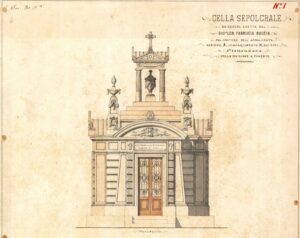Besides being an attempt to bring closure to the deceased’s family and friends and a manifestation of the desire to respect the dead, human burial practices are marked by the religious views of both society and the individual.
With the resurrection of Christ and a belief in the resurrection of the body at its core, Christianity has always ensured that the bodies of the faithful were treated with respect and buried them in a safe place. Christians had less need than their neighbours to appease their dead, who were themselves less likely to return as unhappy ghosts.

In the second half of the first millennium, graves began to cluster in and around churches. This process shaped the landscape of Western Christendom, with the living and the dead forming a single community, sharing a common space. These developments unified western Europe more around shared rituals than common political structures.
The document shown here is the plan of a sepulchral chapel submitted by Emanuele Luigi Galizia in 1872, to be located at the Maria Addolorata Cemetery in Malta.
It shines a light on the evolution of burial customs in Christianity, in this instance the introduction of extra-mural cemeteries in mid-19th century Malta.

Unless death was due to a plague or contagious disease, the strong preference of the Maltese was for intramural burial in churches and chapels around their local area. The introduction of extra-mural cemeteries in mid-19th century Malta created a great deal of controversy. The local church was vehemently opposed to both the principle of establishing burial grounds outside the confines of local parishes and the principle of multi-faith interment.
The impetus for change came from a scathing sanitary report on the health risk of continued burials in overcrowded harbour churches, along with the fact that the Protestant burial grounds had reached capacity. The issue was resolved in Malta with the promulgation of the Burial Ordinance in May 1869 prohibiting the burial of corpses within the five harbour cities (Valletta, Floriana, Vittoriosa, Senglea and Cospicua), the most densely-populated areas of Malta. Addolorata Cemetery was opened around that date, growing over time to become Malta’s largest burial ground.
At first, the population refused to use Addolorata Cemetery. In fact, it would take three years before anyone was buried in this cemetery, that eventually became Malta’s largest.
Written by Leonard Callus,
National Archives of Malta
